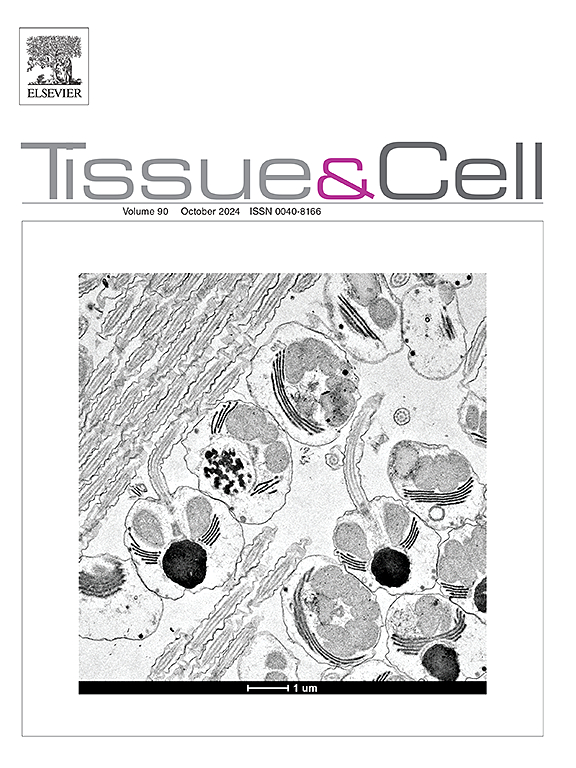Histological-based characterization of ovarian developmental stages in blue crab (Callinectes sapidus) within the spawning season in the central western Adriatic Sea
IF 2.5
4区 生物学
Q1 ANATOMY & MORPHOLOGY
引用次数: 0
Abstract
The Atlantic blue crab (Callinectes sapidus Rathbun, 1896) is a euryhaline and eurythermal species native to the Atlantic coasts of the Americas. Although its widespread distribution across the Mediterranean basin is well documented, information on its reproductive patterns remains limited. This study focused on the combination of both macroscopic and histologic characterization of ovarian developmental stages in female blue crabs along the north-central Italian Adriatic coast, within the spawning period. Samples were collected off the coast of Ancona, in collaboration with local fishermen, between September and November 2023. For each specimen, sex and biometric parameters were recorded to determine the sex ratio, while size distribution and gonadosomatic index (GSI) were calculated for female specimens. Ovary samples and eggs sponge were collected to determine the ovarian developmental stage and fecundity respectively. Results showed females as the dominant sex throughout the sampling period, with males being extremely rare. The collapse of female catches in early November, alongside the consistent presence of ovigerous females and the strong female-biased sex ratio, identified this area as a spawning ground. These findings align with reproductive patterns observed in the species’ native range and other Mediterranean areas. Moreover, GSI values and fecundity indexes associated with macroscopic and histological examination of ovarian stages suggested that the end of the reproductive season corresponded to mid-November.
亚得里亚海中西部产卵季节蓝蟹卵巢发育阶段的组织学特征
大西洋蓝蟹(Callinectes sapidus Rathbun, 1896)是一种原产于美洲大西洋海岸的泛盐性和泛热性物种。虽然它在地中海盆地的广泛分布有充分的记录,但关于其繁殖模式的资料仍然有限。本研究的重点是结合意大利中北部亚得里亚海沿岸雌性蓝蟹产卵期卵巢发育阶段的宏观和组织学特征。在2023年9月至11月期间,与当地渔民合作,在安科纳海岸附近收集了样本。记录每个标本的性别和生物特征参数以确定性别比,同时计算雌性标本的大小分布和性腺指数(GSI)。采集卵巢标本和卵海绵,分别测定卵巢发育阶段和繁殖力。结果显示,在整个采样期间,雌性为优势性别,雄性极为罕见。11月初雌鱼捕获量的减少,以及持续存在的雌鱼和强烈的雌性偏向性比例,确定了这个地区是一个产卵地。这些发现与在该物种的原生地和其他地中海地区观察到的繁殖模式一致。此外,GSI值和与卵巢分期的宏观和组织学检查相关的繁殖力指数表明,生殖季节的结束对应于11月中旬。
本文章由计算机程序翻译,如有差异,请以英文原文为准。
求助全文
约1分钟内获得全文
求助全文
来源期刊

Tissue & cell
医学-解剖学与形态学
CiteScore
3.90
自引率
0.00%
发文量
234
期刊介绍:
Tissue and Cell is devoted to original research on the organization of cells, subcellular and extracellular components at all levels, including the grouping and interrelations of cells in tissues and organs. The journal encourages submission of ultrastructural studies that provide novel insights into structure, function and physiology of cells and tissues, in health and disease. Bioengineering and stem cells studies focused on the description of morphological and/or histological data are also welcomed.
Studies investigating the effect of compounds and/or substances on structure of cells and tissues are generally outside the scope of this journal. For consideration, studies should contain a clear rationale on the use of (a) given substance(s), have a compelling morphological and structural focus and present novel incremental findings from previous literature.
 求助内容:
求助内容: 应助结果提醒方式:
应助结果提醒方式:


